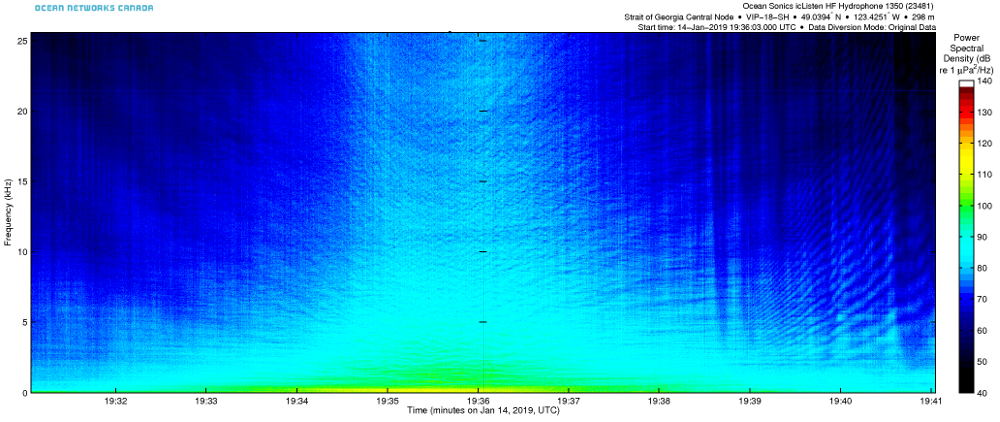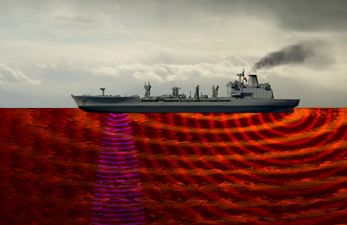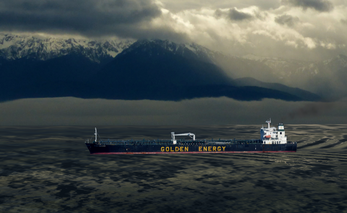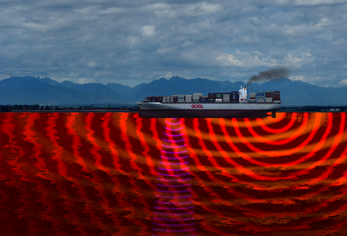Acoustic Turbulence
*This application tracks basic data, see transparency statement bellow Program File Size 32mb
| Controls | Mouse | Keyboard |
| Move Camera | Left Click + Drag Up/Down | Up & Down Arrow or W & S |
| Zoom | Scroll Wheel | Left & Right Arrow
or A & D |
| Change Scenes | Left Click + Drag Right/ Left | Shift & Space Bar |
Acoustic Turbulence
Colton Hash: Ocean Networks Canada Artist in Residence
instagram: @colton.hash
Project Description
Acoustic Turbulence is an interactive art application that presents visualizations of underwater noise generated by pollution from large ocean vessels. This exploratory program allows viewers to experience unfiltered hydrophone recordings of the passage of various ships through the Salish Sea. Acoustic Turbulence allows viewers to move a virtual camera vertically between a representational surface environment and an abstracted submarine environment. This transition is abrupt. Most vessel noise is generated below the waterline, and sound propagates farther and more rapidly through ocean water than through air. Viewers can transition between different scenes of shipping lanes within the Salish Sea. Each scene features a specific class of vessel, and contains a representative hydrophone recording. Acoustic Turbulence presents viewers with a choice between the visual soundscapes they experience. Generated from each freighter, a representation of atmospheric emissions is shown above the ocean surface, while an abstracted visualization of acoustic pollution is rendered below. Acoustic Turbulence creates an impetus to consider our cultural relationships to the marine environments that surround us. This application presents a specific regional environmental and cultural context, but the relationships shown are generalizable across many of the world’s marine environments.
Input Data
Acoustic Turbulence is driven by hydrophone data recorded by Ocean Networks Canada in the Strait of Georgia, southwest of Vancouver BC. Spectrograms of audio data are used as direct input to computer graphics code which renders an abstracted representation in real time. With validation from marine vessel tracking software, data sets were gathered for particular vessel classes that are representative of the vessels frequenting the Port of Vancouver. High resolution photographs of similar ships and background scenes were captured within the Salish Sea. Composed together as an interactive computer graphics program, viewers are presented with a subset of rich media to intuitively explore.

Spectrogram for passage of Densa Panther (bulk carrier) through Strait of Georgia
Recorded January 14, 2019 by Ocean Networks Canada
Scientific Description
| The vessels which connect ports across the world’s oceans are
inextricably linked to the development and maintenance of our global
economy. Large freighters allow for relatively efficient transportation
of commercial goods, but cumulatively impact the world’s oceans and
atmosphere. These vessels often burn low-grade bunker fuel, emitting significant sources of particulate matter, carbon
dioxide, nitrogen oxides and sulfur oxides. Marine vessels also impact
the acoustic environment of marine ecosystems. Sound propagates farther
and more rapidly through water than through air; low frequency noise is
especially pervasive. Sound waves are reflected off of the ocean surface
as well as underwater terrain features. Sound propagation varies with
seawater properties such as salinity, temperature and pressure. Noise
from marine vessels interferes with the ability of acoustically oriented
animals to communicate and find prey. Acoustic habitat fragmentation is
of particular concern to the survival of the Southern Resident Killer
Whales which inhabit the Salish Sea. Ships produce sound at frequencies
used by whales and other marine mammals to communicate, feed, navigate
and reproduce. Noise pollution can mask killer whale communication and
echolocation signals, making it more difficult for them to locate and
hunt salmon. Marine vessels are categorized by size and capabilities into different classes, allowing for comparisons of their impacts. Each vessel has a unique acoustic footprint based on its construction and how well it is maintained. Noise from marine vessels is primarily generated by the stream of bubbles created from their propellers. Propellers displace water as they rotate and create low pressure areas which ‘boil’ water, continually generating vapour-filled bubbles that collapse and produce noise over a wide frequency band. The large engines located within vessels emit lower frequency noise, and these sounds can be amplified by the large metal hulls of ships. Most vessels also operate high frequency sonar for depth sounding, which create localized sound at high decibels. Newer ships are being constructed with quieter machinery, and older vessels can be cleaned and retrofitted to produce less noise. There are some incentives for ship owners to voluntarily reduce underwater noise but so far there is no global authority mandating that ships operate below certain decibel levels. |
Links for more information:
Ocean Acoustics (Ocean Networks Canada)
Underwater Noise (Clear Seas)
Commercial Ships Could be Quieter, but They Aren’t (Hakai Magazine)
Air pollution & Marine Shipping (Clear Seas)
Drowning in Noise (Georgia Strait Alliance)
Ship noise extends to frequencies used for echolocation by endangered killer whales (PeerJ)
Study reveals underwater noise is reduced when ships slow down (Port of Vancouver)
Thanks to: Tom Dakin, Kristen Kanes, Dwight Owens, Kim Juniper, Lesslie Elliott, Mandy Leith, Paul Walde, Ashton Sciacallo
*Data Tracking Transparency
This application uses basic analytics provided through Unity. Metrics are automatically collected, such as duration of app use, and your country of origin (determined by IP address) I have also added a few custom metrics such as time spent on each scene, and what scenes are viewed the most. This data can not be used to identify with individuals and I will NEVER sell this data to anyone. Basic analytics are included in virtually every website on the internet, and do offer some insight on usage and effectiveness of applications. I am mostly interested in gathering statistical data of usage, to be able to potentially include these statistics in grant applications.
| Status | Released |
| Category | Other |
| Platforms | HTML5 |
| Author | Colton Hash |


